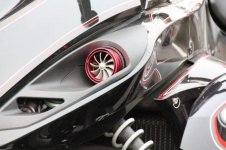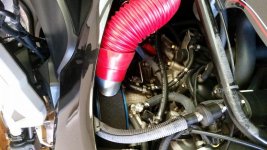Next silly question ...
Has anyone ever done anything with ram air intakes ? Obviously asking because in all the years of tweaking and playing, I have next to no experience with them.
However, thinking I wouldn't mind crossing a semi forced induction ram air intake with a particle separator style intake, that are mainly used on aircraft. ( ... think about a normally aspirated engine - then go to the other 'extremes' of turbo or super-charging, ... now back up the train to about half way between these two extremes and there sits what I envisage)
As an aside, particle separators, I'm very familiar with from my days of working with rotory engines and helicopters (Allison turbines especially ... And I see when I began 'googling' this stuff again, low and behold both Polaris and Can Am are all over it for their adventure off road series of turbos and the like ... bugger me ... C'mon BRP ... catch up with the Spyders yet again ...
Well its been a few weeks, but there's heaps of research going on and if anything everything has been getting harder along the way, with all sorts of evolving ideas ...
Above all else and just as important to me if doing this is to 'do things right and do them neatly.'
Current problems with my lower left leg prosthetic have given me the perfect timing and excuse to pull down a bunch of panels and start to really have a close look at whats happening as stock. Like anything mechanical, I need to know the starting point before I just head off blindly ... The more I have this bike the more I am truly impressed with the engineers employed to build it at BRP .... Everything is or has in my mind at least, been vary well thought out for fit, function and form ...
So right now both sets of side panels are off the beast ... The Frunk and enclosed liner have been removed, as has the front under headlight combing shroud ... And so I spent a good couple of hours today assessing and just looking towards the quality of what is there ... all in an attempt to mindfully and genuinely improve that dreadedinflux of cool air.
Please do not take this as being at all demeaning in the way it 'may' sound, but 'for the uninitiated' and those who have never ventured there ... The 'air-box' intake on the F3 is located just in front of where your left knee is positioned when riding ... But, just under that too is the hot air being omitted by the engine. So there in lies the quandary and area for any possible airflow improvement ... Why? Just because its there and I can!
The actual open air intake to the air-box is a little over 75mm or 3" in diameter ... A huge thing that is directly located behind and inboard of the F3's EMU/ECU. Main problem there is, ... Just how to get the extra cool air flow up and into that air intake without impeding or restricting the existing airflow.
Once again I say the engineers at BRP have done a pretty amazing job, but everything with regards mass production is impaired by the holly dollar! As it is designed it is a restricted area of a little over 30mm or just over 1 1/4" to the left main support brace and directly above the front 1/3rd of the engine to that main air duct, so to me that's another reason it can be improved ..
Beginning to look at the science behind this, I know as we move forward the hot air is being cooled by forward air pushing it rearwards as we ride, but in reality it is very seldom we are doing 'highway' speeds to sweep away all that hot air for any real length of time ... So come on in cool air ... Just how to I get it there in an efficient way so it can best do its job? Particularly with-out cutting, chopping, sawing or inhibiting any of that adjacent fitment or design ..
My current thoughts ...
1) Possibly slightly (and stylishly) elevate the face of the hood of the frunk by an inch or so, so as to create an 'air dam' for a ram tube effect. Then also do incorporate the 'added yet removable' bodywork without drilling and screwing anything other than to the existing drilled holes and support areas of the hood frunk area.
2) Supply 2 x Ram air catchments then duct from either side of about the area of the fog lights bringing that back possibly under pressure via that open air 3" intake ... which again is quite 'doable'
3) And my least enthusiastic thought so far, is to access another forward inlet into the 'face' of the giant existing air box itself from about the area immediately behind the existing F3's grill ... could be under added pressure flow as well ... any other suggestions appreciated ... :yikes: :yikes: :yikes:


